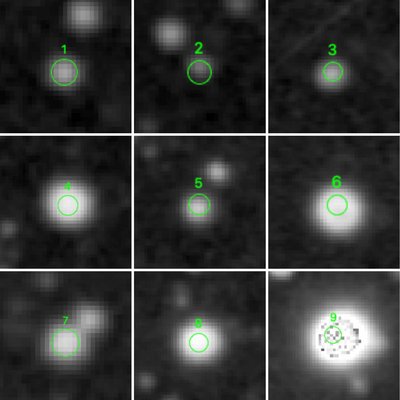Contemporary scientific application
Glass plates are exceptionally useful in time-domain astronomy and for recording unique astronomical events.
Some of the plates in the Yerkes collection date to the 1890s, giving contemporary astronomers access to data ranging nearly 130 years. This information is irreplaceable – the sky will never again be the same as it was at any given day at any given time – and is therefore also invaluable to those studying long-term phenomenas as well as particular moments or events.

Figure 4 from Cerney, et. al. "Precise Photographic Measurement from a 1903 Photographic Plate Using a Commercial Scanner." 2021 PASP 133 044501.
The "guest star" is clearly seen within the center of the red circle between the white hash marks in the 1905 image on the left, while it does not appear in the SDSS image on the right.
Supernovae
While researching the feasibility of determining star magnitudes using a commercial scanner in the course of the work on the EAGER grant, students made an unexpected discovery. Examination of Ry60, taken in 1903 at Yerkes and centered on NGC 7331, revealed a "guest star" on the plate. Research confirmed the source was not debris or a scratch on the plate, it did not appear in SDSS or other contemporary images, nor did it appear in another plate taken at a similar time from Yerkes.
Due to its magnitude, the guest star could not be a classical nova as it would be much too faint. It also was unlikely to be a Solar System object as it does not trail (the exposure time of the plate is 3 hours.) Therefore, we suspect the star is likely to be a previously unreported supernova, serendipitously discovered in the course of other research. Data from this research can be found at Knowledge@UChicago.
We are also continuing research on how to use plates to study known supernovae. We are currently digitizing and studying a set of 16 survey plates from 1901-1904 document Nova Persei and a set of spectra from Nova Herculis (DQ Herc) to explore the potential and limitations of our digitizations methods on these types of images.

Figure 12 in pending publication
A comparison of catalogs identified these 9 possible RSGs on the 1905 plate. Star 8, WY Gem, is a known variable. The analysis of data derived with our methods indicates that WY Gem can indeed be identified as a variable based on the 1905 plate.
Variable stars
Long-term stellar variability study is a natural match for historic plates, which can confirm variability on the time scale of a century or more and increase accuracy on period measurements. To test how the output of our digitization and transformation methods could be used to confirm variability, we identified red supergiants (RSGs) in our catalog and did boutique analysis on each of the 9 candidates to determine their magnitude offset and standard deviation.
Our methods do have limitations – 1 of the 9 stars was too bright to be measured accurately, and another overlapped with a close companion star, so its measurement was also skewed. However, one of the 9 identified RSGs did show a significant standard deviation in magnitude between 2022 and 1905. This star, WY Gem, is a known, long-term variable RSG. Further information about this work is included in an upcoming publication, and all data used is available at the Knowledge@UChicago repository.
While not a novel discovery, this work does indeed indicate that data produced via our methods of digitization and transformation is useful in study of variable stars.
These 2 examples barely scratch the surface of what can be accomplished with data from historic plates. There are multitudes of other applications that can be explored and large scale digitization of plates to increase their availability can unlock data for researchers around the world.